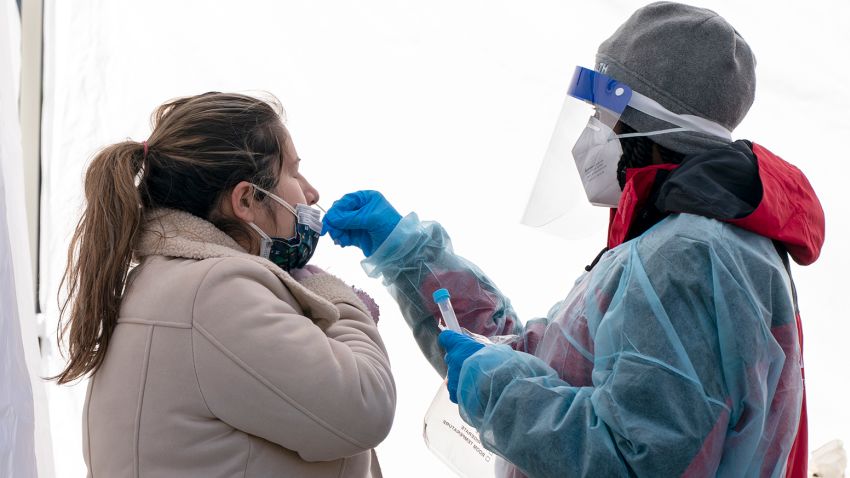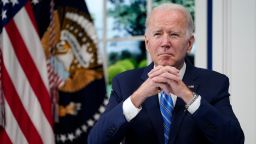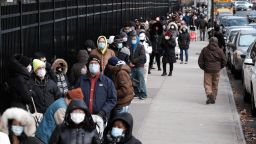President Joe Biden is closing out his first year in office facing one of the same problems he entered the White House vowing to fix: a persistent shortage of Covid-19 testing that, if resolved, could provide a way out of the still-raging pandemic.
The inability to secure enough timely tests for the number of people who want them has led to a new reckoning for Biden’s Covid-19 response. An enhanced strategy that includes distributing 500 million free at-home tests didn’t come in time to prevent major disruptions to holiday travel, and it remains unclear when those tests will reach Americans who want them.
Walking along the seafront in Rehoboth Beach, Delaware, Biden said on Tuesday that he’d made “a bit of progress” in distributing the new tests. But he didn’t expand on how far along the program was.
A combination of factors – from a Christmastime surge in demand to a highly transmissible new variant to a summertime lull in testing that created a shortage of supply – are driving the testing deficit, officials and others familiar with the matter say.
Yet the failures surrounding testing have led to accusations that the White House failed to anticipate the pandemic’s course and overemphasized vaccinations as a solution to ending the crisis, even as outside experts warned of a looming test shortage directly to administration officials.
Biden’s team insists they took what steps they could in the fall to build up testing capacity but acknowledge that a surge in demand and relatively recent emergency use authorizations from the US Food and Drug Administration have made stockpiling at-home tests a challenge.
Television footage of long lines at testing centers grabbed Biden’s attention over the Christmas weekend. And the shortage of tests factored into the administration’s decision Monday not to recommend tests for individuals exposed to the virus to emerge from a shortened five-day quarantine, according to an official familiar with the discussions.
“If we require a test, people are going to say, ‘What if we can’t get a test?’ ” the senior administration official said, recounting internal deliberations on condition of anonymity. “Rather than letting the perfect be the enemy of the good,” the official said, the US Centers for Disease Control and Prevention opted for less stringent language, noting that “best practice would also include a test for SARS-CoV-2 at day 5 after exposure.”
Biden himself has frankly acknowledged that his efforts have fallen short, particularly in scaling up testing, even as he seeks to take credit for other aspects of fighting the pandemic.
“It’s clearly not enough. If I had – we had – known, we would have gone harder, quicker, if we could have,” Biden said in describing his testing efforts this week while meeting virtually with governors. “We have to do more. We have to do better, and we will.”
Other top health officials, including Dr. Anthony Fauci, the President’s top medical adviser, have similarly acknowledged the testing shortfalls in interviews. And White House press secretary Jen Psaki conceded last week that she could have provided more context when she dismissed the notion of sending tests to Americans just two weeks ago.
Officials said a letup in demand for tests over the summer and fall, despite the rapid spread of the Delta variant, had caused some companies to pull back their manufacturing, which has compounded the current shortages. Many of the drive-thru sites that opened earlier in Biden’s tenure were closed, and Abbott, which manufactures a popular at-home product, discarded materials for millions of its tests and laid off workers.
Despite steps the White House has taken since then to ramp up production, including deploying the Defense Production Act, public health experts have decried the shortfalls.
“I cannot believe this is where we are almost two years into the pandemic. Everybody saw it coming. We knew we needed more tests. I think the administration had dropped the ball on this,” said Dr. Ashish Jha, dean of Brown University’s School of Public Health. “They focused a lot on vaccines, which is terrific – vaccines are a really, really important part of this – but did not pay enough attention to testing. And I think it has been really costly in this holiday season.”
“I hope we fix it in January and February, but we’re going to have to have a real effort to make sure there’s plentiful, cheap, ubiquitous testing everywhere in the country,” Jha said. “That’s where we should be in this pandemic right now.”
New controversy
On Tuesday, a second backlash – this time against the CDC’s decision to shorten the recommended isolation period for those who test positive for Covid-19 – was bubbling among some public health and medical experts. The agency did not recommend a negative test as part of the conditions for ending isolation; instead, the new recommendation is that those without symptoms can end their isolation after five days instead of 10, and wear a mask for the ensuing five days.
The move was “a sign that we expect cases to only grow,” one senior health official told CNN.
The step was a boon for businesses, including major airlines, which had been forced to dramatically scale back their business as employees tested positive and were unavailable to work for 10 days. Carriers including JetBlue and Delta Air Lines had lobbied the administration to shorten the isolation period for positive cases; Delta asked to cut it to five days specifically.
While the CDC said the change was “motivated by science” in its announcement Monday night, officials did not deny that a concern the Omicron wave could effectively “shut down society” had also played a role, according to one senior official.
“We need people to get back to their jobs,” the official said.
Speaking on CNN, Fauci said it was imperative to ensure essential personnel were able to continue working.
“With the sheer volume of new cases that we are having and that we expect to continue with Omicron, one of the things we want to be careful of is that we don’t have so many people out,” Fauci said Monday night on CNN. “If you are asymptomatic and you are infected, we want to get people back to the jobs – particularly those with essential jobs – to keep our society running smoothly.”
Officials said the new guidance was subject to extensive discussion among administration health officials before it was announced Monday evening, with a final decision made on Sunday. A senior official said there had been near-unanimity about the decision. The biggest sticking point in the talks was how long people exposed to the virus should quarantine. The agency ultimately recommended a reduced five-day quarantine for people who are unvaccinated or not yet boosted.
The conversations among officials included weighing the availability of tests, one official said, along with the imperative of allowing businesses to continue operating amid the surge.
“I was very surprised that there was not a testing requirement to come out of isolation,” said Dr. Celine Gounder, an infectious disease specialist who served on Biden’s coronavirus task force during the transition. “Symptoms are really not a good way of determining if someone is infectious or not.”
Like other medical experts who have been critical of the updated guidance, Gounder argued it is “irresponsible” to halve the isolation period without requiring a negative antigen test.
While the Biden administration came into office promising its coronavirus response would be driven by science, Gounder said the lack of a testing requirement to shorten the isolation period suggests science was not the driving force in the new guidance.
“I think this is policy being driven by scarcity. And this is not the first time we have seen this happen,” Gounder said, noting CDC recommendations on masking that have not urged the use of medical-grade masks in order to preserve them for health care workers. “Public health policy is going to be driven not just by science, but by political, economic and social considerations. But I do feel like science is taking a back seat here.”
A senior administration official involved in the deliberations said the CDC guidance focused on the absence of symptoms, rather than a negative test, because antigen tests can be unpredictable “later in the course of infection.” The official also noted that the FDA has not approved antigen tests as a way of determining whether someone is still infectious.
Still, with tests in short supply in certain areas of the country, officials were forced to weigh availability against a recommendation to test before exiting quarantine.
Unanswered questions about new testing plan
Officials say the scarcity of at-home tests this month was driven by a steep uptick in demand, particularly in major cities where cases began surging at the same moment Americans were entering the holiday stretch. Increased travel and family get-togethers prompted fresh urgency in getting tested that depleted stocks of at-home tests at drugstores and online.
The plan Biden announced last week to procure and distribute hundreds of millions of at-hope rapid tests developed quickly over a stretch of days in December as reports emerged of empty shelves and sold-out notices, according to officials familiar with the matter.
Still, when Biden made the announcement last week, several details of the plan remained unresolved. Administration officials were unable to provide any specific details about when the website to request the tests would launch or how quickly tests would be shipped, pointing only to a broad timeline of early January. They also did not detail a plan to get tests to those with limited internet access.
“We’re working through all the details. And we’ll have those in the coming weeks,” a senior administration official said during a briefing. The official said the “first deliveries” of those tests would happen in January and that the website would launch “in January or around January as well.” The official also said the White House is “working through all the details” when asked how Americans without internet access could secure tests.
A buildup of factors over the past year led to a shortfall in testing that became apparent only as the Omicron variant began spreading across the country in the weeks after Thanksgiving, according to administration officials and others familiar with the matter.
Biden entered office vowing to remedy the testing issues that had plagued the previous administration, and he signed an executive order on his first day in office meant to expand the availability of testing, including in schools and other “priority populations.”
He established a Pandemic Testing Board – a campaign promise modeled on President Franklin D. Roosevelt’s War Production Board – early in his term. And in February, he announced a series of investments meant to increase testing capacity by scaling up the production of raw materials and establishing regional centers to distribute test kits and collect samples.
But Biden’s central focus in the early days of his term ultimately was on getting as many Americans vaccinated as possible, a campaign that diverted public attention away from the testing initiative he’d entered office vowing to execute.
In September, Biden announced he was using the Defense Production Act to increase the production of rapid tests, including at-home products. He said major retailers including Walmart, Kroger and Amazon would soon begin selling the at-home kits at cost, and he announced a purchase of 300 million rapid tests to be distributed to community health centers, food banks and schools.
At the same time, administration officials said the process of getting FDA authorization for at-home test products has been slower than some inside the White House would like, leading to products that have become available only in recent months. For the White House, the focus over the fall was on building capacity within the test market to produce the billions of tests that will be necessary to ending the pandemic.
In October, a group of medical experts urged the White House during an “informal and informative” meeting to expand the nation’s testing capacity in an effort to stem a winter surge, according to one of the participants, former Harvard School of Public Health assistant professor Michael Mina.
Mina, who now serves as chief science officer of at-home test maker eMed, was one of a number of medical professionals who presented the White House with a 10-page plan calling for, among other measures, procuring 732 million tests per month. He acknowledged a surge in testing at that scale was always a tall order.
“I think the bold initiative, had it come to fruition, would have been amazing,” Mina said in an interview on CNN last week. He said that since the meeting, the administration has worked to scale up US testing capacity – an effort that was still unable to prevent the long lines and shortages that have plagued the last months of 2021.
“It would have been very, very difficult in the last two months,” he said.







